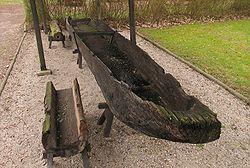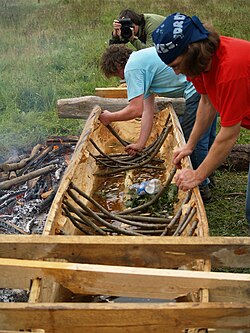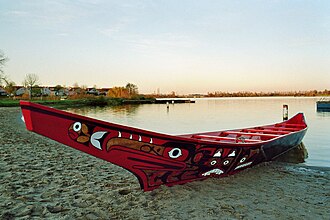Difference between revisions of "AY Honors/Canoe Building/Answer Key"
m (138 revisions from w:Dugout (boat)) |
m (Transwiki:Dugout (boat) moved to AY Honor Canoe Building: transwiki merge of w:Dugout (boat)) |
(No difference)
| |
Revision as of 03:44, 2 December 2008
A dugout is a boat which is basically a hollowed tree trunk. Other names for this type of boat are logboat and monoxylon. Monoxylon (μονόξυλον) (pl: monoxyla) is Greek -- mono (single) + xylon (tree) -- and is mostly used in classic Greek texts.
Dugouts are the oldest boats archaeologists have found. In Germany they are called Einbaum (English translation: One tree). Einbaum dug-out boat finds in Germany date back to the Stone Age. Along with bark and hide canoes, these dugout boats were used by American Indians. This is probably because they are made of massive pieces of wood, which tend to preserve better than, e.g., bark canoes.
Construction
Construction of a dugout begins with the selection of a log of suitable dimensions. Sufficient wood needed to be removed to make the vessel relatively light in weight and buoyant, yet still strong enough to support the crew and cargo. Specific types of wood were often preferred based on their strength, durability, and weight. The shape of the boat is then fashioned to minimize drag, with sharp ends at the bow and stern.
First the bark is removed from the exterior. Before the appearance of metal tools, dugouts were hollowed-out using controlled fires. The burnt wood was then removed using an adze. Another method using tools is to chop out parallel notches across the interior span of the wood, then split out and remove the wood from between the notches. Once hollowed out, the interior was dressed and smoothed out with a knife or adze.
For travel in the rougher waters of the ocean, dugouts can be fitted with outriggers. One or two smaller logs are mounted parallel to the main hull by long poles. In the case of two outriggers, one is mounted to either side of the hull.
.
Africa
The well-watered tropical rainforest and woodland regions of sub-Saharan Africa provide both the waterways and the trees for dugout canoes, which are commonplace from the Limpopo River basin in the south through East and Central Africa and across to West Africa. African Teak is the timber favoured for their construction, though this comprises a number of different species, and is in short supply in some areas. Dugouts are paddled across deep lakes and rivers or punted through channels in swamps (see makoro) or in shallow areas, and are used for transport, fishing and hunting, including, in the past, the very dangerous hunting of hippopotamus. Dugouts are called pirogues in Francophone areas of Africa.
Eastern Europe
De Administrando Imperio details how the Slavs built monoxyla that they sold to Vikings in Kiev.& These ships were then used against Byzantium during the Rus'-Byzantine War of the ninth and tenth centuries. They used dugouts to attack Constantinople and to withdraw into their lands with bewildering speed and mobility. Hence, the name of Δρομίται ("people on the run") applied to the Rus in some Byzantine sources. The monoxyla were often accompanied by larger galleys, that served as command and control centres. Each Slavic dugout could hold from 40 to 70 warriors.
The Cossacks of the Zaporozhian Host were also renowned for their artful use of dugouts, which issued from the Dnieper to raid the shores of the Black Sea in the 16th and 17th centuries. Using small, shallow-draft, and highly manoeuvrable galleys known as chaiky, they moved swiftly across the Black Sea. According to the Cossacks' own records, these vessels, carrying a 50 to 70 man crew, could reach the Anatolian coast of Asia Minor from the mouth of the Dnieper River in forty hours.
In Estonia dugout canoes are built in the area of Soomaa National Park.hi
Northern Europe
Dugout boats have been found in Scandinavia and Germany. In German, the craft are known as einbaum (one-tree). Apparently, such boats were used for mundane tasks such as fishing or transport on calmer bodies of water. & Dugouts require no metal parts or shipbuilding expertise, and were likely common amongst farming folk in Northern Europe until large trees suitable for making this type of watercraft became scarce. Length was limited to the size of trees in the old-growth forests -- up to 10 meters (around 30 feet) in length. & Later models increased freeboard (and seaworthiness) by lashing additional boards to the side of the boat. Eventually, the dugout portion was reduced to a solid keel, and the lashed boards on the sides became a Lapstrake hull.
Indigenous Peoples of North America
The Indigenous of the Pacific Northwest are very skilled at crafting wood. Best known for totem poles up to Template:Convert tall, they also construct dugout canoes over Template:Convert long for everyday use and ceremonial purposes.&
In 1978 Geordie Tochler and two companions, sailed a 3½ ton, 40 foot (12 m) dugout canoe (the "Orenda II"), made of Douglas Fir, and based on Haida designs (but with sails), from Vancouver, Canada to Hawaii to add credibility to stories that the Haida had travelled to Hawaii in ancient times. Altogether they travelled some 4,500 miles (7,242 km) after two months at sea.&&
Dugout canoes were constructed throughout the Americas where suitable logs were available.
United Kingdom
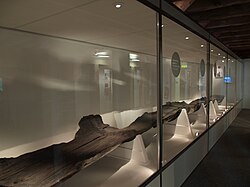
Two log boats were discovered in Newport, Shropshire and are now on display at Harper Adams University College Newport. The Iron Age residents of Great Britain were known to have used logboats for fishing and basic trade. In 1964, a logboat was uncovered in Poole Harbour, Dorset. The Poole Logboat dated to 300 BC was large enough to accommodate 18 people and was constructed from a giant Oak tree. It is currently located in the Poole Museum. The dugouts are made from wood.
Pacific Islands
- See also Māori migration canoes, Waka
In the Pacific Islands, dugout canoes are very large, made from whole mature trees and fitted with outriggers for increased stability in the ocean, and were once used for long-distance travel. Such are the very large waka used by Māori who ventured to New Zealand many centuries ago. Such vessels carried 40 to 80 warriors in sheltered waters or smaller numbers thousands of miles across the Pacific ocean. In Hawaii, canoes are traditionally manufactured from the trunk of the koa tree. They typically carry a crew of six: one steersman and five paddlers.
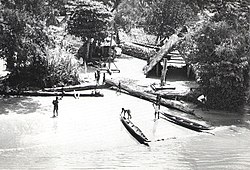
Biuki Gasa and John F. Kennedy's PT-109
In World War II, the Solomon Islanders were (and still are) using dugout canoes to travel between Japanese occupied islands. After an Australian observer saw the explosion of the torpedo boat PT-109 after it was rammed by a Japanese destroyer, he dispatched native scouts on dugout canoes in search of survivors, even though the U.S. Navy had given them up as lost. Biuki Gasa would be recognized as one of the first two islanders to reach the shipwrecked John F. Kennedy, and deliver a message inscribed on a coconut (later displayed on the president's desk, and now in the John. F. Kennedy presidential library) by dugout canoe at risk of capture by Japanese authorities to the nearest allied base. These canoes with their small visual and noise signatures would be among the smallest boats used by the Allied forces in World War II. Gasa would be invited to Kennedy's inauguration only to be turned back by a clerk who did not understand his language. Gasa's village would construct a special canoe to send back with the National Geographic crew to present to the people of the USA so that they would remember this incident.
External links
- Fundamental origins of ship types
- Ship replicas in the world
- How to Make A Dugout Canoe
- For more information on Tocher's voyage
Template:Sailing vessels and rigs
cs:Monoxyl de:Einbaum es:Cayuco eo:Trunkoboato fr:Monoxyle is:Eintrjáningur it:Cayuco nl:Boomstamkano ja:丸木舟 no:Stokkebåt pl:Dłubanki ru:Чёлн fi:Ruuhi vi:Thuyền độc mộc
- ↑ Excerpt from the "De Administrando Imperio" with self-study questions.
- ↑ [1] Viking era dugout boat found in lake
- ↑ [2]
- ↑ [3] Pacific Northwest Coastal Indians website
- ↑ Robert Stall, "A man, a tree and an ocean to cross." Maclean's magazine, March 5, 1979, pp. 4-6.
- ↑ Peter Speck. "Orenda recalled." North Shore News. November 22, 1978, pp. 2 and 12.
